MANUSCRIPTS
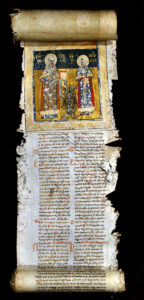
Manuscripts of Gelati Monastery
During its existence, the most important monuments of Georgian culture, literature and ethnography were gathered in Gelati Monastery. Even before entering the Kutaisi Museum — before 1923, they were attracting the special interest of Georgian and foreign scientists. This is a clear confirmation of meritorious researchers: M. Brose, D. Bakradze, N. Kondakov, T. Jordania, G. Tsereteli, P. Uvarova, E. Takaishvili, M. Janashvili, N. Mari, Z. Chichinadze, A. Khakhanashvili, Iv. Javakhishvili, S. Kakabadze, K. Kekelidze, P. Ingorova, Vuk. Beridze, S. Makalatia and others’ works and fundamental researches. Among the Gelatian materials, the priceless treasure of the Georgian national culture is the old handwritten books, whose chronological framework covers the 10th-19th centuries. It should be noted that the Gelati monastery manuscripts contain material corresponding to all three stages of the development of the Georgian alphabet: sacred, translated or original writings transcribed in Asomaturli, Nuskha-Khutsuri and Mkhedruli.
Our letter is not intended to provide readers with scrupulous information about Gelatian manuscripts. This is impossible, because their scientific value is so great that dozens of monographs can be written on each of them — at this stage, we will focus only on the interest of Georgian researchers in Gelatian manuscripts, on the topic of scientific works created on them in recent years. In addition, since a separate catalog of Gelatian manuscript books has not been published to date, and since they are included in the catalog of manuscript books of the Kutaisi Museum compiled by Ev. Nikoladze (Vol. I-II, ed. 1953-1964), we will allow ourselves to select Gelatian manuscripts out from Ev. Nikoladze’s catalog with short descriptions and attach them to our letter. Those interested in this will have the opportunity to get acquainted with the topic of Gelatian handwritten books directly in our letter.
The arrival of Gelatian manuscripts in the Kutaisi Museum is connected with the name of the famous public figure, the first director of the museum, an excellent scientist and publicist Triphon Japaridze.
Triphon Japaridze, as the trustee of protection of antiquities and art monuments, showed great interest in recording and protection of cultural and historical monuments. To a certain extent, it is his merit that today, in Western Georgia, we have survived many excellent monuments of religious purpose after the anti-religious destruction of the 30-ies of XX centuary.
By 1923, churches began to be massively closed in Georgia. The Georgian repousee art pieces and unique handwritten books preserved in the churches were in danger. Triphon Japaridze did everything to save the national wealth in the churches of the action zone.
In 1923, with his direct participation, the manuscript books preserved in the Gelati Monastery were housed in Kutaisi Museum and are still preserved here, with some exceptions.
By transferring the Gelatian manuscripts to the museum, they became more accessible for scientific research, and a wide representation of researchers — O. Soselia, R. Kenia, A. Shanidze, Il. Abuladze, E. Metreveli, S. Tsaishvili, S. Kubaneishvili, M. Shanidze, Sh. Gozalishvili, I. Lolashvili, A. Baramidze, L. Menabdi, D. Bregadze, Ev. Nikoladze, M. Rafava, D. Melikishvili, E. Gabidzashvili and others made a significant contribution to the study and popularization of Gelatian manuscripts.
The interest of Georgian researchers in Gelati materials is great even today. E. Machavariani, Z. Sarjveladze, Z. Skhirtladze, M. Machkhaneli, T. Abuladze, N. Melikishvili, Z. Raphava, T. Otkhmezuri, S. Sarjveladze, V. Jugeli, T. Aldamidze, M. Abutidze, E. Giunashvili, I. Chichinadze, N. Kavtaria, E. Kochlamazashvili, N. Kajaia, M. Nikoleishvili and others worked on the Gelatian manuscripts and published interesting works and articles. The topics of the issues studied by them were also diverse, among the issues studied are “Old Georgian translations of the works of Grigol Nazianzeli», Commentaries on the works of “Grigol Nazianzeli», “Old Georgian homiletics», “Issues of the language style of the Gelati monastic school», and the determination of the text of Anastasi Sineli’s “Foreword», “Arsen Ikaltoeli’s Dogmaticon», “Establishment of the four-chapter critical text», and others.
It should be noted that the handwritten books that are today referred to as Gelatian manuscripts were not all created or translated in Gelati monastery itself: N19; N20; N21 John Chrysostom’s translation of the Gospels of Matthew and John — exegetical writings were transcribed in Manglisi and Atskuri monasteries, then donated to the Katskhi monastery, but due to the situation of the times, they ended up in the Gelati monastery and today they are included in the Georgian scientific literature as Gelati manuscripts. Thus, not only foreign or original Georgian works were translated in the Gelati Monastery, but during its existence, due to favorable natural conditions, which made it almost inaccessible during the war, it was generally considered a shelter and treasury of Georgian culture and works of art. That is why the geographical area of origin of Gelati materials — handwritten books, samples of Georgian goldsmithing, monuments depicting ethnographic presence is very wide and it covers almost the whole Western Georgia.
The themes of the Gelatian manuscripts are very diverse, this is evidenced by the list of these manuscripts with short descriptions, which, as we mentioned above, we collected from the description of the manuscripts of the Kutaisi Museum compiled by Ev. Nikoladze:
1
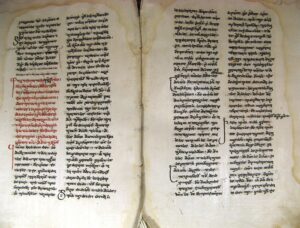
K-1 — Metaphrases – (XVI century) 582 sheets. Size 41.5X27; paper leather-bound wooden cover; the list Headings painted by Cinnabar; There are 44 notebooks with old pagination; The text is written in two columns; each column has 32-33 lines.
2

K-2 — Metaphrases – (XIV century) 401 sheets. size 28X26; paper leather-bound wooden cover; the list Headings painted by Cinnabar; defective, damaged; Place of copying was given (270 r.); There are 52 notebooks with old pagination; The text is written in two columns — each column has 32 lines, commissioned by Catholicos Ephvtime (401 notebook); Superintendent Onofre (401 notebook).
3
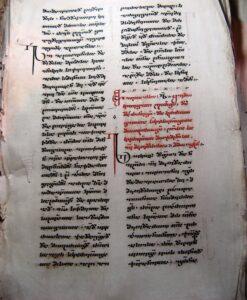
K-3 — Metaphrases – (XVI century) 752 sheets. Size 41X27.5; paper leather-bound wooden cover; the list Headings painted by Cinnabar; defective, damaged; There are 96 notebooks with old pagination; The text is written in two columns, each column has 32 lines.
4
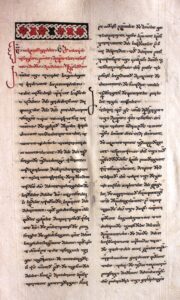
K-4 — Metaphrases — 1565 669 sheets. size 42X28; paper leather-bound wooden cover; the list Headings painted by Cinnabar; defective, damaged; There are 84 notebooks with old pagination; The text is written in two columns, each column has 32 lines; The book contains cryptographic inscriptions (444 sh, 484 sh, 585 sh) copied by Manoel (668.); Eudaimon the Catholicos of Abkhazia (668 n.); Copying place Gelati.
5
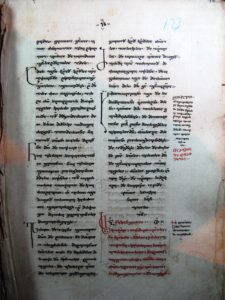
K-5 — Metaphrase – (XVI century) 579 sheets. Size 40X26.5; paper leather-bound wooden cover; the list Headings painted by Cinnabar; defective, damaged; There are 74 notebooks with old pagination; The text is written by two different hands in two columns, each column has 30-34 lines; Ordered Catholic Eudemon of Abkhazia (493 n.)
6
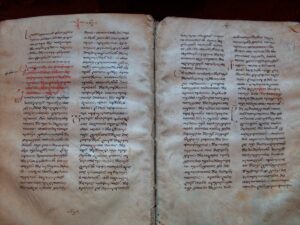
K- 6 — Metaphrase – (XIII century) 94 sheets. size 37X29; parchment keep the list Headings painted by Cinnabar; defective, damaged; The text is written in two columns, each column has 31 lines.
7

K-7-Metaphrase – (XIII century) 422 sheets. size 33X26; parchment keep the list Headings painted by Cinnabar; defective, damaged; The text is written in two columns, each column has 26 lines.
8
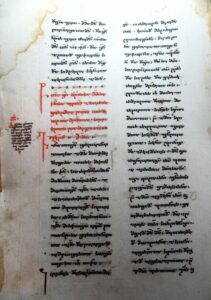
K-8 — Metaphrase – (XIV century) 986 sheets. size 40X27; paper leather-bound wooden cover; the list Headings painted by Cinnabar; defective, damaged; It is written in two columns, each column has 30-31 lines. copyist monks Onofre (7 n.) and Manoel (746 n.); Ordered Catholicos Ekvtime of Abkhazia (986 n.).
9
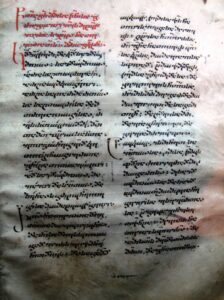
K-9 — Gregory the Theologian — Word — (XIII century); 340 sheets. size 36X29; parchment, leather-bound wooden cover; the list Headings painted by Cinnabar; damaged; There are 44 notebooks with old pagination, the text is written in two columns with 25 lines in each column; Archbishop of Kutaisi Theophile (339 sh.) who was newly “recognized» of the book; decorated by Okropir Kavjaradze (330 V).
10
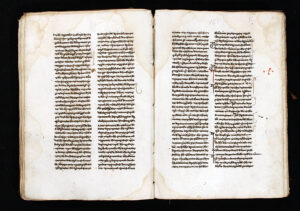
K-10 -Josippos Flavios — Book of Hebrews — (XVI century); 420 sheets. size 30X21; Paper, leather-bound wooden cover; the list Headings painted by Cinnabar; There are 54 notebooks with old pagination, the text is written by different hands in two columns — each column has 32-33 lines. Ordered by Eftvime Catholicos of Abkhazia (420v).
11

K-11 — Typicon – (XVII century); 220 sheets. Size 22.5X16.5; Paper leather-bound wooden cover; the list Headings painted by Cinnabar; Headless — damaged.
12
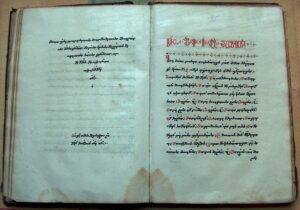
K-12 — Kondakion — (XVII century.); 77 sheets. size 29X30; Paper leather-bound wooden cover; the list Headings painted by Cinnabar; damaged; Transcriber hierodeacon John (34v).
13

K-13 — Metaphrases – (XVI); 218 sheets. size 40X27; cardboard cover; the list Headings painted by Cinnabar; defective, damaged; It is written in two columns, each column has 31 lines.
14
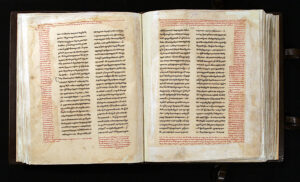
K-14 — Maxime the Confessor — writings — (XII century) 310 p. size 38X29; Paper leather-bound wooden cover; the list titles painted by Cinnabar, inscriptions on chapters in Singur, the text is written in two columns, there are 28 lines in a column; restored.
15

K-15 — Dogmaticon – (XVII-XVIII centuries); 270 sheets. size 42X28; paper leather-covered wooden cover; Nuskhuri, headings painted by Cinnabar; There are 31 notebooks with old pagination; The text is written in two columns, each column has 54 lines.
16
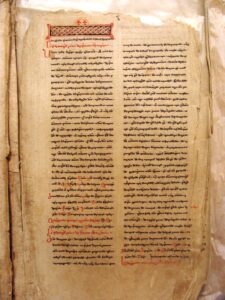
K-16 — Gulan – (XVII century); 1203 sheets. Size – 42.5X27; paper leather-bound wooden cover; the list Headings painted by Cinnabar; defective, damaged; The text is written in two columns, each column has 40 lines; copyist Svimon Meskhi from Kargaret (1203v); Ordered by Archbishop of Kutaisi Svimeon Chkhetidze.
17

K-17 — Law of Justice – (XIII century); 486 sheets. Size 29X21.5; paper leather-bound wooden cover; List titles and capita letters painted by Cinnabar; flawed damaged; Damaged pages are restored; It was updated by someone called — Joseph by the order of Nicholas the Catholicos of Kartli in 1589. (486 sh.).
18

K-18 — Metaphrase – (XVIII century); 367 sheets. size 32X21; leather-bound wooden cover; Nuskhur, headings painted by Cinnabar; The text is written in two columns, each column has 29 lines, the copyist was the solitary priest-monk of the Gelati monastery Nkioloz Morchadze (367); Place — Gelati.
19
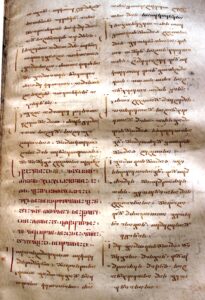
K-19 — John Chrysostom — «Translation of the Gospel of Matthew» — 1047 551 sheets. Size 45.5X31.5; Parchment, leather-bound wooden cover, nuskhuri, titles with capital letters painted by Cinnabar; There are 69 notebooks with old pagination; The text is written in two columns — each column has 29 lines; scriber Gabriel (551 sheet), place of copying Manglisi, commissioned by Eristav-Eristav Liparit.
20

K-20 — John Chrysostom — translation of the Gospel of Matthew — 1048 524 sheet. size 45X30; Leather covered wooden cover — decorated with small silver balls, on both sides of the cover there is a cross with silver balls; Index, headings and capital letters of paragraphs painted by Cinnabar; The text is written in two columns, each column has 29 lines; Transcriber Gabriel, place – Manglisi; The donator is Eristavt — Eristavi Liparit.
21

K-21 — John Chrysostom — translation of the Gospel of John — 1053 484 sheet. size 45X30; parchment, leather-bound wooden cover; Parallel lines are drawn with small silver balls on both halves of the sleeve; Nuskhuri, titles and capital letters of paragraphs painted by Cinnabar; It is written in two columns, there are 28-30 lines in a column; Transcriber – Gabriel; Place – Atskuri; The customer is Eristavt-Eristavi Liparit.
22

K-22 — Hymns – (XIII century); 238 sheets. size 17,5X14, parchment; leather-bound wooden cover; the list Headings and first letters of paragraphs in Asomtavruli painted by Cinnabar; defective, damaged; There are 30 notebooks with old pagination.
23

K-23 — dogmatist – (XIII century); 458 sheets. Size 33.5X25.5; Parchment, wooden cover; Nuskhuri, headings painted by Cinnabar; flawed; The text is written in two columns, each column has 31-32 lines.
24

K-24 — Dogmaticon – (XIV century); 303 sheets. size 32X25; Parchment, leather-bound tufted wood cover; the list Headings painted by Cinnabar; defective, damaged; The text is written in two columns, each column has 31 lines; Inscriptions are made on the frames, animals are drawn in some places.
25
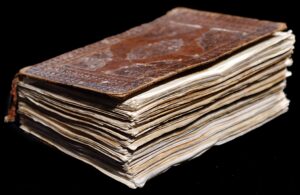
K-25 — Law of Justice – (XIII century) 312 sheets. Size 28X18.5 paper, leather-bound tufted wood cover; Nuskhur, headings painted by Cinnabar; defective, damaged; has a simple harness; Transcribed by Grigol Chakhrukhaisdze.
26
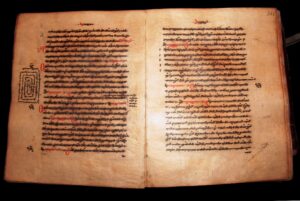
K-26 — Law of Justice — 1761 437 sheets. Size 20.5X16; paper, leather-bound tufted wood cover; Nuskhuri, headings painted by Cinnabar; defective, damaged; Transcribed by priest of Cross Monastery John (427v); Order of Catholicos Joseph.
27

K-27 — Horologion – (XVII-XVIII); 240 sh. Size 14X9.5; paper, leather-bound wooden cover; the list Headings painted by Cinnabar; flawed damaged.
28
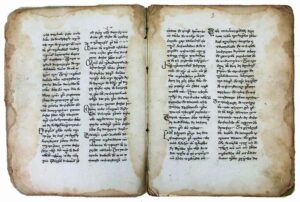
K-28 — Genesis – 1681; 210 sh. Size 28X21.5; paper keep the list Titles painted by Cinnabar; defective, damaged; The text is written in two columns, each column has 26 lines.
29
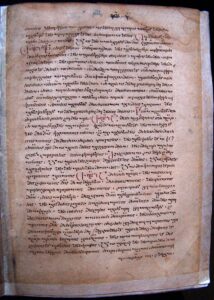
K-29 — Ephraim the Small – “Translation of Psalter” — (XII-XIV); 365 sh. Size 30.5X22.5; paper, leather-bound wooden cover; the list Headings painted by Cinnabar; Defective, damaged.
30

K-30 — Lent and Paschal season readings — (XVIII century); 229 sh. size 31X20; paper leather-bound tufted wood cover; Nuskhur, headings painted by Cinnabar; The text is written in two columns, each column has 31 lines, copyist Lazarus; Ordered Archbishop Antony (229v).
31

K-31 _ Ioane Sinelli — Clemax — 1776; 255 sh. 20X15; Paper, leather-bound, tufted wood cover; the list Headings painted by Cinnabar; Order of Catholicos Joseph (239v).
32
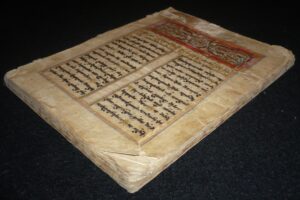
K-32 — Kondakion and Hieratikon – (XVII); 112 sh; 24X18; paper, leather cover is gilded; defective, damaged; The text is surrounded by a sheet of paper; In some places, the titles have headgear.
33

K-33 — Holiday — 1740 271 sh; 23X18; paper, leather-bound tufted wood cover; the list Headings painted by Cinnabar; defective, damaged; Transcriber Archdeacon John (237r). Place – Tbilisi; Ordered by prior Silibistro (242v).
34

K-34 — Words of the Holy Fathers – (XVII); 193 sh. size 32X22; paper, leather-bound wooden cover; the list Headings painted by Cinnabar; The text is written in two columns, each column has 32-37 lines.
35
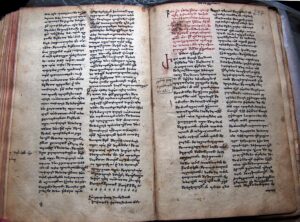
K-35 — Words of the Holy fathers – (XVII); 255 sh. size 29X20; paper, leather-bound tufted wood cover; the list Headings painted by Cinnabar; defective, damaged; The text is written in two columns; Each column has 33-35 lines.
36
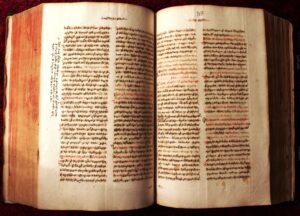
K-36 — Menaia («books of the months») – (XVII–XIX); 614 sh. size 31X20; paper, leather-bound tufted wood cover; Mkhedruli, titles painted by Cinnabar; The text is written in two columns.
37
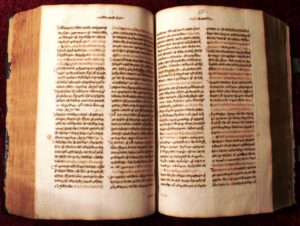
K-37 — Menaia («books of the months») – (XVIII–XIX); 489 sh. size 30X20; paper, Leather covered tweed wooden cover; riding Headings painted by Cinnabar; The text is written in two columns.
38

K-38 — Liturgical Books’ collection “Gulani” — 1579-1612; 1084 sh. Size 30.5X21; paper, leather-bound wooden cover; the list Headings painted by Cinnabar; defective, damaged; transcribers: Nathanael (48 sh.), Giorgi (159 v.), Zebede (328 sh.), John (1084 sh.); Ordered by Eftvim Catholicos of Abkhazia (48v).
39
K-39 — The Gospel – XI (transferred to the State Museum of Georgia Q-908).
40

K-40 — Studies and Spiritual stories — (XIII-XIV) 252 sh. Size 38X25.5; paper; Nuskhuri, headings painted by Cinnabar; defective, damaged; The text is written in two columns.
41
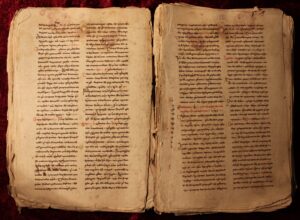
K-41 — Menaia («books of the months») – (XVIII); 382 sh. size 36X25; paper, the list Headings painted by Cinnabar; defective, damaged; The text is written in two columns.
42

K-42 — Liturgical Feasts Book – (XVII-XVIII); 339 sh; size 41X28; paper, Leather-covered tufted wooden cover; the list in some places, there are colorful pictures of saints on the edges.
43
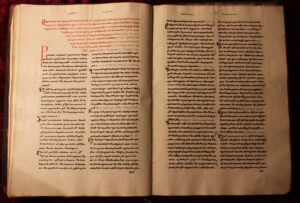
K- 43 — Metaphrase — 1806 137 sh. size 42X30; paper, leather-bound tufted wood cover; Nuskhuri, headings painted by Cinnabar; damaged; The text is written in two columns; Transcriber – Ose Gabaon (137r).
44

K-44 — Metaphrase – (XVIII); 133 sh. size 41X30; paper, the list Headings painted by Cinnabar; with no cover, defective, damaged; The text is written in two columns.
45
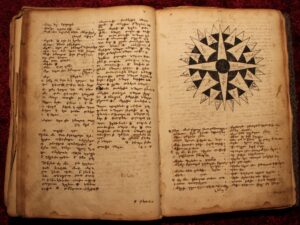
K-208 — Sulkhan-Saba Orbeliani — Georgian Dictionary — (XIX); 142 sh. size 29.5X19, paper; Cloth covered wooden cover; titles and Capital letters painted by Cinnabar; Defective, damaged.
46
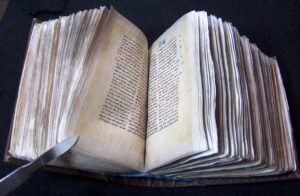
K-449 — Liturgical Books’ collection “Gulani” – (XVII); 596 sh. size 12X8; paper, Nuskhuri, headings painted by Cinnabar; flawed
47

K-450- church readings – (XVII-XVIII); 53 sh. size 21X16; paper list; Headings painted by Cinnabar; flawed.
48
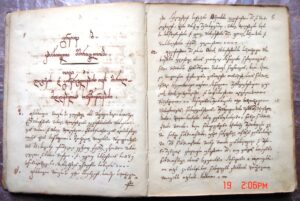
K-458 — Typicon of the Theological Consistory – (XIX) 272 sh. size 22X17; paper, Cloth covered cardboard cover; Headings painted by Cinnabar.
49
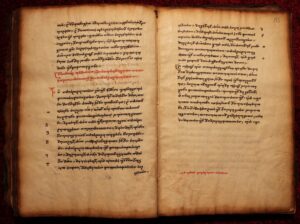
K-461 — Book of Ammonios – (XVI-XVII); 245 sh. size 26X17; paper, leather covered tufted wood cover; the list Headings painted by Cinnabar; flawed.
50
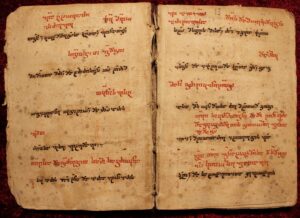
K-467 — Hymns – (XVII-XVIII); 85 sh. Size 12X8.5; paper, keep the list Damaged, missing.
51

K-468 — Cannon Law – (XVIII); 70 sh. size 10X7; paper, leather-bound wooden cover; the list Headings painted by Cinnabar. damaged.
52
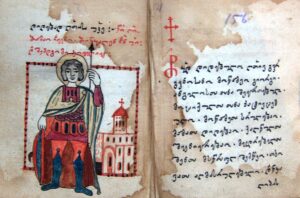
K-469 — Life of st. George — 1819 161 sh. Size 10.5X8.5; paper, leather-bound wooden cover; Headings painted by Cinnabar; copyist Ose Gabaon (134v); pictured.
53
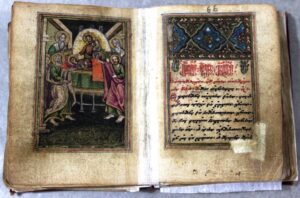
K-470 — Hymns — 1742 118 sh. Size 9X6.5; paper, Red velvet lined cardboard cover; Nuskhuri, headings painted by Cinnabar; Damaged pictured.
54
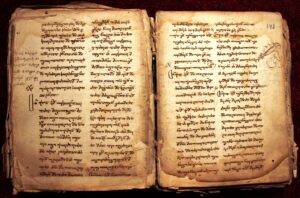
K-494 — Studies and Epistle — (XVIII); 292 sh. Size 16.5X12.5; Paper, leather-bound tufted wood cover; the list Headings painted by Cinnabar; flawed, Transcriber Deacon Abram (51r).
55
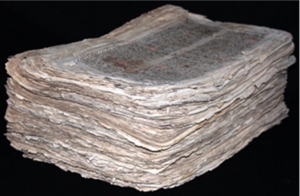
K-596 — Gulan – 1541 687 sh. size 41X27; paper, wooden cover, Nuskhuri, headings painted by Cinnabar; flawed; It is written in two columns; In some places the upper letters are decorated; Transcribers: Gerasime Lechia and Isak Tsimtsadze; Ordered by Catholicos of Abkhazia Eudemon (687v).
56
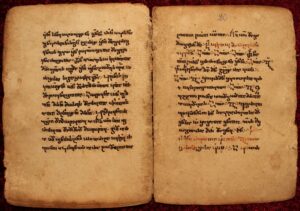
K-627 — reading-hymns — (XVII-XVIII); 23 sh. size 13X10; paper, wooden cover covered with leather; the list Headings painted by Cinnabar; flawed.
57
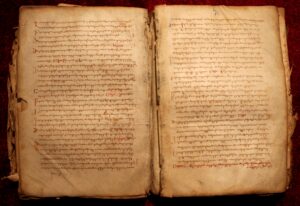
K-644 — Liturgical book of festivals’– (XIV-XV); 103 sh. Size 23.5X18; parchment, undressed; Index, titles are painted by Cinnabar, missing.
58
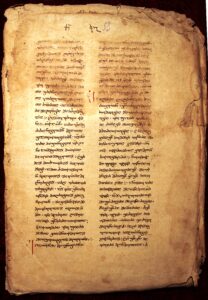
K-648 — Gospel translations – (XVI-XVII); 82 sh. size 30X27; paper list, damaged.
59
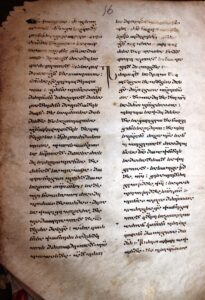
K-653 — Lives of Saints – (XVI); 41 sh. Size 35.6X17; parchment, undressed, the list Headings painted by Cinnabar; flawed.
60
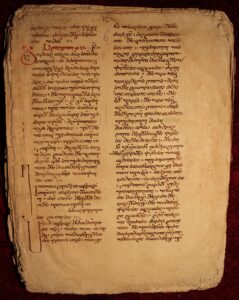
K-654 — Part of the writings of Ephraim Sirian – (XVI); 78 sh. size 42X32); paper, the list Headings painted by Cinnabar; flawed, damaged.
61

K-670 — Prayer book – (XVIII); 119 sh. size 7X4; Paper, leather-bound wooden cover; the list Headings painted by Cinnabar; missing sheets have been replaced by handwritten blue paper sheets from a later period.
62
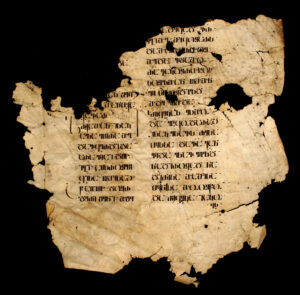


 ____________________
____________________
 ___________________________
___________________________
 ___________________________
___________________________
 ___________________________
___________________________
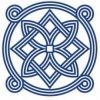 ___________________________
___________________________
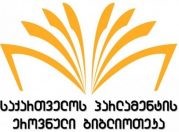 ___________________________
___________________________